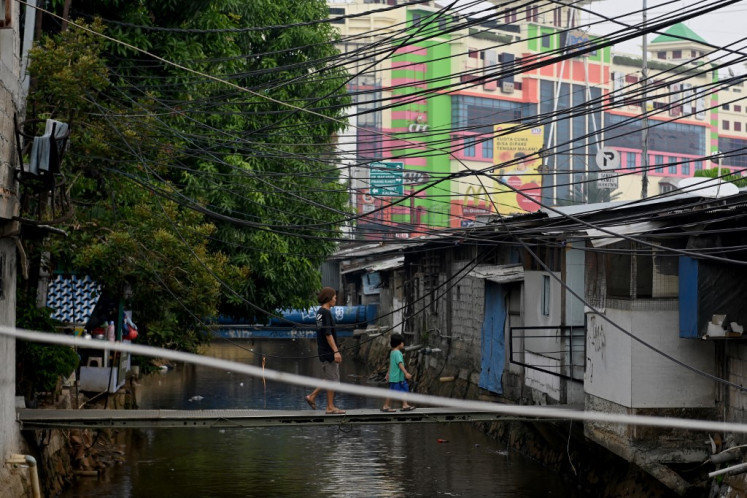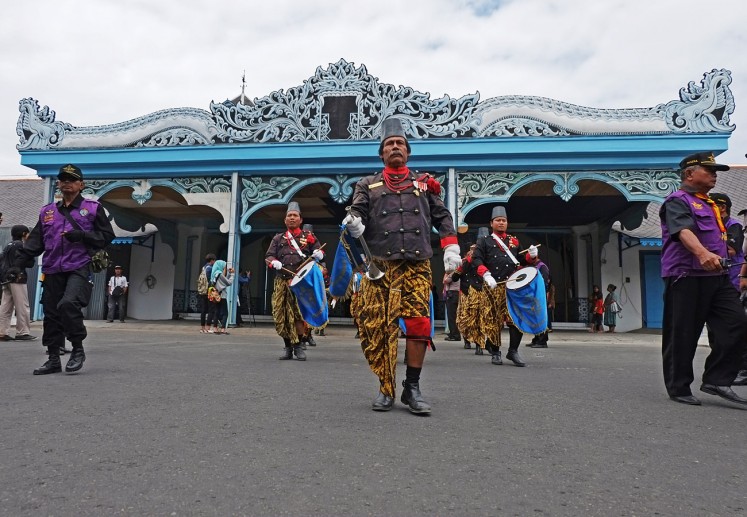Decoding batik
Chic: A collection from Purana
Change text size
Gift Premium Articles
to Anyone
 Chic: A collection from Purana. (Courtesy of Galeri Indonesia Kaya) (Courtesy of Galeri Indonesia Kaya)
Chic: A collection from Purana. (Courtesy of Galeri Indonesia Kaya) (Courtesy of Galeri Indonesia Kaya)
Chic: A collection from Purana. (Courtesy of Galeri Indonesia Kaya)
To know batik better, especially why premium batik cloth can cost millions of rupiah for a cloth measuring around 1 by 1.5 meters, the first thing is to recognize the definition of batik.
'Batik is a technique,' batik enthusiast, entrepreneur and master of ceremonies Wethandrie Ramadhan said during a talk titled Fabulous Batik of Java in Jakarta recently.
UNESCO, which designated Indonesian batik as a Masterpiece of Oral and Intangible Heritage of Humanity in 2009, says the craftwork 'is dyed by proud craftspeople who draw designs on fabric using dots and lines of hot wax, which resist vegetable and other dyes and allow the artisan to color selectively by soaking the cloth in one color, removing the wax with boiling water and repeating if multiple colors are desired'.
'When you practice such dye resistance techniques in decorating a piece of cloth, you can call the product batik,' said Wethandrie, who is also known as Iwet.
Iwet said the technique can also be found in places like India, Egypt, China and even the US.
'Indian people in the US also acknowledge the batik technique. However, they use tapioca flour [to resist the dyes]. Other places use balsam and rice starch,' he explained. 'For Indonesian batik, especially in Java, we're famous for using canting pen and wax,' he said, adding the name 'batik' derived from the Javanese words 'amba' (to write) and 'nitik' (dots).
Iwet, who owns the Tik Prive batik line, expressed his true love for batik, particularly in regard to the complexities in its creation.
'Just like any other international brands like Hermes, Chanel and Louis Vuitton, which require meticulous craftspeople to make their products, batik applies the same work ethic. It's important for all of us to know the principles of batik, instead of just wearing it,' he added.
UNESCO says Indonesian batik techniques, symbolism and culture surrounding hand-dyed cotton and silk garments permeate the lives of Indonesians from beginning to end: infants are carried in batik slings decorated with symbols designed to bring the child luck, and the dead are shrouded in funerary batik.
In terms of motif, batik carries both beautiful and meaningful lines in every part.
Speaking about batik motifs, Iwet suggested Indonesians get to know some classic batik motifs, which he said were a true fine art.
'The batik of Java is spread inland, in Yogyakarta and Surakarta, as well as in coastal areas, such as Pekalongan and Lasem of Rembang [in Central Java], Cirebon [in West Java] and Tuban [in East Java],' he said.
Batik motifs from Yogyakarta and Surakarta are divided into lereng (hill, diagonal rows), ceplok (a wide range of geometric designs often based on circular rosettes, stars or other small shapes forming an overall symmetric pattern on the cloth) and semen (carries pictographic designs, mostly an interpretation of gunungan, or mountain symbol, in wayang puppet shows) categories.
Parang is listed under the lereng category. The motif symbolizes authority. Another lereng motif, udan riris, symbolizes fortune.
In the ceplok category, the inland area has the most classic motif, truntum. Behind this particular motif lies a tale.
'I've been told that back in the era of Kasunanan Pakubuwono III, the king was about to marry one of his mistresses. The queen felt very sad about the marriage plan,' said Iwet.
'However, a king's speech was an order and the queen could not do much to cancel it. With a heavy heart, the queen expressed her sadness by drawing the stars on a piece of cloth, which was later known as truntum batik.'
Iwet explained the king noticed his wife's creation and was amazed by its perfection. He then decided to cancel the marriage with his mistress,' shared Iwet, adding that truntum came from the word 'tinaruntum', which meant 'grow'.
One motif in the semen category, babon anggrem (a hatching chicken), symbolizes good luck in business.
'Each classic motif in batik cloth carries a prayer from the maker. So, one who wears ceplok batik is expected to become a disciplined person.
'A businessman who owns a batik cloth with a babon anggrem motif will enjoy good earnings. The motif also symbolizes persistence,' said Iwet.
From the coastal area, there is the famous tiga negeri motif, which Iwet claims to be the 'Hermes of Indonesian batik'.
There are three colors in tiga negeri that are produced in three different areas. The red is from Lasem, the brown from Surakarta and the blue from Pekalongan.
'Back in the early days of tiga negeri batik, the cloth was carried by horse to different cities for coloring.
'Tiga negeri batik was also known for grouping together ethnicities in the coastal area because, at that time, Chinese ladies would only wear batik in red, while the Javanese would only take brown. This batik was so gorgeous that all the ladies wanted to wear it,' said Iwet.
Most motifs on batik cloths from coastal areas are in the form of as butterflies (symbols of love) and birds (happiness), as well as flowers, including the lotus (perfection) and peony (love).
In terms of production, Iwet said many batik makers in the regions faced difficulties as most craftspeople chose to work in other kinds of factories, including jeans factories, given the better wages.
'For a batik cloth worth, let say, Rp 12 million, a batik factory usually needs eight to 10 people to produce the piece within two years. Each month, the factory has to spend Rp 500,000 on production costs. It is equal to Rp 50,000 in wages for each worker in the project,' he said.
Iwet added the fact that most batik artisans only worked based on their moods could trouble entrepreneurs. 'Imagine having to deal with these moods whenever we receive high demand from buyers overseas?'









